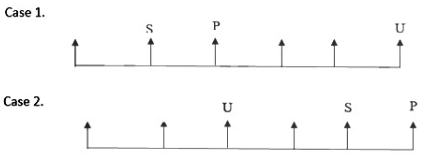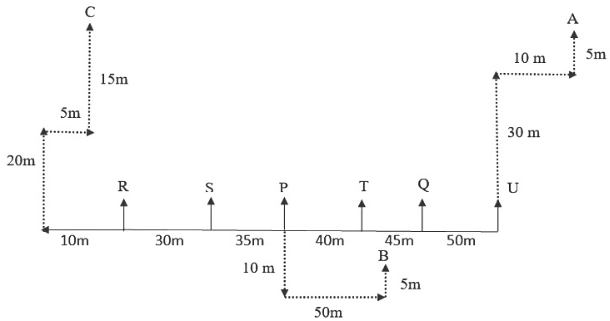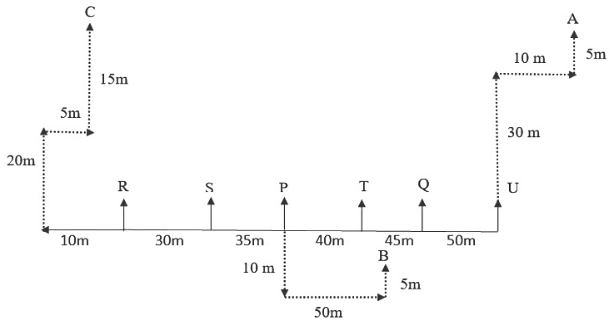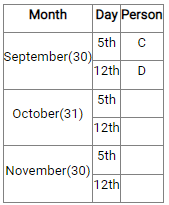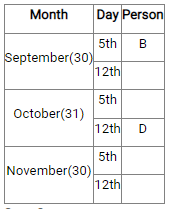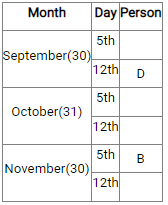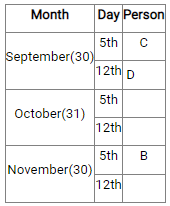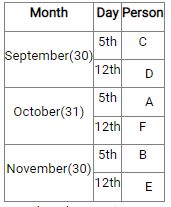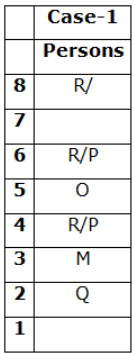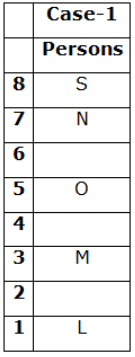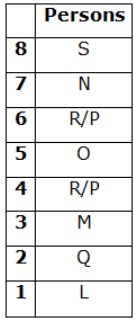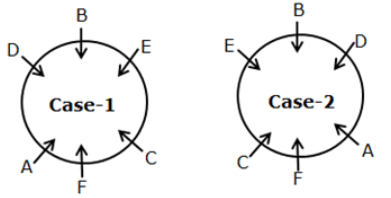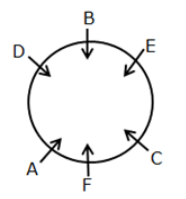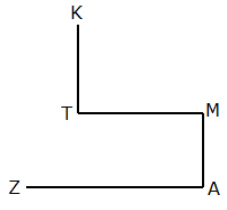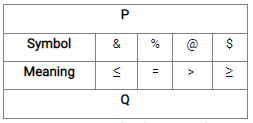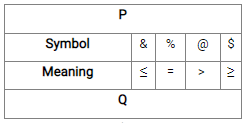IBPS RRB PO (Scale 1) Mains Mock Test - 3 - Bank Exams MCQ
30 Questions MCQ Test - IBPS RRB PO (Scale 1) Mains Mock Test - 3
In the given group of letters ABSUDSX if every letter which is at even position is replaced by the previous letter and every letter which is at odd position is replaced by the next letter according to the English alphabet dictionary then how many three-letter meaningful English words can be formed by 2nd, 6th and 7th letter after rearrangement. No letter will be repeated. If one word is formed than what will be 1st letter of that word. If two words can be formed answer will be Y and more than three words are formed, the answer will be Z.
If it is possible to make only one meaningful five letters English word with the first, second and the third letters of the word TREE, together with the first, second and fourth letters of the word WEEP, then which of the following will be the fourth letter of the newly formed word? If no such word can be made give ‘X’ as the answer and if more than one such word can be made give ‘Y’ as the answer.
Study the following information carefully and answer the questions given below.
A number arrangement machine when given an input line of numbers, it performs some mathematical operations in each step
Input: 348914 463581 986457 654386 146748 872351
Step I: 984431 865431 987654 866543 876441 875321
Step II: 05 21 23 02 26 60
Step III: 25 09 25 04 64 36
Step IV: 16 16 21 60 28
Step V: 37 37 05 36 68
Step V is the final step of the above input
As per the rules followed in the given steps, find appropriate steps for the given input
Input: 143765 265986 864763 344578 848754 354789
Q. What is the sum of the numbers which are second from the left end in step II and fourth from the right end in Step IV?
Study the following information carefully and answer the questions given below.
A number arrangement machine when given an input line of numbers, it performs some mathematical operations in each step
Input: 348914 463581 986457 654386 146748 872351
Step I: 984431 865431 987654 866543 876441 875321
Step II: 05 21 23 02 26 60
Step III: 25 09 25 04 64 36
Step IV: 16 16 21 60 28
Step V: 37 37 05 36 68
Step V is the final step of the above input
As per the rules followed in the given steps, find appropriate steps for the given input
Input: 143765 265986 864763 344578 848754 354789
Q. Which of the following number is third to the left of the fourth number from the left end in Step I?
Study the following information carefully and answer the questions given below.
A number arrangement machine when given an input line of numbers, it performs some mathematical operations in each step
Input: 348914 463581 986457 654386 146748 872351
Step I: 984431 865431 987654 866543 876441 875321
Step II: 05 21 23 02 26 60
Step III: 25 09 25 04 64 36
Step IV: 16 16 21 60 28
Step V: 37 37 05 36 68
Step V is the final step of the above input
As per the rules followed in the given steps, find appropriate steps for the given input
Input: 143765 265986 864763 344578 848754 354789
Q. What is the position of “36” in the third step?
Study the following information carefully and answer the questions given below.
A number arrangement machine when given an input line of numbers, it performs some mathematical operations in each step
Input: 348914 463581 986457 654386 146748 872351
Step I: 984431 865431 987654 866543 876441 875321
Step II: 05 21 23 02 26 60
Step III: 25 09 25 04 64 36
Step IV: 16 16 21 60 28
Step V: 37 37 05 36 68
Step V is the final step of the above input
As per the rules followed in the given steps, find appropriate steps for the given input
Input: 143765 265986 864763 344578 848754 354789
Q. Which of the following number is third from the left end in penultimate step?
The consonants in the word 'HOUSEWARMING' are changed to the respective previous alphabets in the English alphabetical series and the vowels are changed to the respective alphabets succeeding them in the series. Any alphabet which is repeated in the word thus formed is eliminated. How many pairs of letters in the word formed after arranging the remaining letters in alphabetical order have as many letters between them in the word (both forward and backward direction) as they have between them in the English alphabetical series?
Directions: Study the following information carefully and answer the questions given below.
Six buses P, Q, R, S, T and U are made to stand in a row facing north and the distance between two adjacent buses increases from left to right, in consecutive integral multiple of 5. Only two buses stand between P and U, one of them stands at the right end of the row. The distance between R and T is 105 meters. The distance between T and U is 95 meters. T stands somewhere to the left of U. S stands immediate to the left of P. Only one bus stands between S and T. Bus U starts towards North, after moving 30 meters, it turns to its right and moved 10 meters. Again it turns left and moves 5 meters it reaches at a point A. Bus P, moves in the South direction for a distance of 10 meters and then turns to its left and moves 50 meters. After taking one more turn to its left it stops at point B after moving 5 meters. Bus R, moves west and travels 10 meters before turning to its right. After moving 20 meters it takes the right turn and moves 5 meters. After taking one more turn to its left it stops at point C after moving 15 meters.
Q. What is the position of Car P with respect of point C?
Directions: Study the following information carefully and answer the questions given below.
Six buses P, Q, R, S, T and U are made to stand in a row facing north and the distance between two adjacent buses increases from left to right, in consecutive integral multiple of 5. Only two buses stand between P and U, one of them stands at the right end of the row. The distance between R and T is 105 meters. The distance between T and U is 95 meters. T stands somewhere to the left of U. S stands immediate to the left of P. Only one bus stands between S and T. Bus U starts towards North, after moving 30 meters, it turns to its right and moved 10 meters. Again it turns left and moves 5 meters it reaches at a point A. Bus P, moves in the South direction for a distance of 10 meters and then turns to its left and moves 50 meters. After taking one more turn to its left it stops at point B after moving 5 meters. Bus R, moves west and travels 10 meters before turning to its right. After moving 20 meters it takes the right turn and moves 5 meters. After taking one more turn to its left it stops at point C after moving 15 meters.
Q. What is the distance between bus S and bus Q?
If all the letters of the words are changed to the second successive letter as per the alphabetical series and arrange the letters in reverse alphabetical order within the word, then which of the following words have vowels each of which is immediately preceded by a consonant?
I. MEMORIAL
II. CHANGE
III. GEOGRAPHY
If all the digits are added within the number, then in which of the following the resultant obtained will be an odd number after subtracting the highest number and lowest number thus formed in each option?
I. 4793, 3782, 5437
II. 4662, 8355, 1347
III. 7742, 6753, 2022
DIRECTION: The question consists of two statements, an assertion and a reason. The student must first determine whether each statement is true. Choose the appropriate option, after reading the two statements carefully.
ASSERTION (A): India is one of the world's fastest-growing economies
REASON (R): The agricultural sector is the largest sector of employment, in India
Direction: question below consists of a question and three statements numbered I, II and III given below it. You have to decide whether the data provided in the statements are sufficient to answer the question.
Six persons A, B, C, D, E, and F have the meeting with the teacher on 5th and 12th in the month of September, October, and November. No two persons have the meeting on the same day. Who among them has the meeting on October 5th?
Statement I: C and D have the meeting in the same month. No person has the meeting before C.
Statement II: B has the meeting on the 5th of a month, which has 30 days. Only two persons have meetings between B and D.
Statement III: B and E have the meeting in the same month. A and E do not have the meeting on the same date.
Study the following information carefully and answer the questions given below.
In a certain code language
“Water level stain molecules sphere” is coded as “O6 H10 I6 V5 M6”
“Core Machine Learn Element Magic” is coded as “V8 G8 V3 M6 X6”
“Each Coating variety Bounce floor” is coded as “T8 S3 V5 I6 B8”
Q. What is the code for the word “Stereotype” in the given code language?
Study the following information carefully and answer the questions given below.
In a certain code language
“Water level stain molecules sphere” is coded as “O6 H10 I6 V5 M6”
“Core Machine Learn Element Magic” is coded as “V8 G8 V3 M6 X6”
“Each Coating variety Bounce floor” is coded as “T8 S3 V5 I6 B8”
Q. How “Variety Element” is coded in the given code language?
Study the following information carefully and answer the questions given below.
In a certain code language
“Water level stain molecules sphere” is coded as “O6 H10 I6 V5 M6”
“Core Machine Learn Element Magic” is coded as “V8 G8 V3 M6 X6”
“Each Coating variety Bounce floor” is coded as “T8 S3 V5 I6 B8”
Q. Which of the following word is coded as “I6” in the given code language?
Study the following information carefully and answer the questions given below.
In a certain code language
“Water level stain molecules sphere” is coded as “O6 H10 I6 V5 M6”
“Core Machine Learn Element Magic” is coded as “V8 G8 V3 M6 X6”
“Each Coating variety Bounce floor” is coded as “T8 S3 V5 I6 B8”
Q. How “World Crisis” is coded in the given code language?
Each of the questions below consists of a question and two statements numbered I and II given below it. You have to decide whether the data provided in the statements are sufficient to answer the questions:
a) If the data in Statement I alone is sufficient to answer the question, while the data in statement II alone is not sufficient to answer the question.
b) If the data in Statement II alone is sufficient to answer the question, while the data in statement I alone is not sufficient to answer the question.
c) If the data either in Statement I alone or in Statement II alone is sufficient to answer the question.
d) If the data in both Statements I and II together are not sufficient to answer the question.
e) If the data in both Statements I and II together are sufficient to answer the question.
Q. Eight persons are living in a eight storey building. The lowermost floor is numbered as 1 and the floor immediately above it is numbered as 2 and so on. R lives on which floor?
Statement I: Q lives either on 2nd or 5th floor. M lives immediately above Q. O lives two floors above M. P lives adjacent floor of O. Only one person lives between R and P.
Statement II: L lives on an odd numbered floor but below fifth floor. Only one person lives between L and M, who lives two floors below O. Only one person lives between O and N. S lives immediately above N.
Each of the questions below consists of a question and two statements numbered I and II given below it. You have to decide whether the data provided in the statements are sufficient to answer the questions:
a) If the data in Statement I alone is sufficient to answer the question, while the data in statement II alone is not sufficient to answer the question.
b) If the data in Statement II alone is sufficient to answer the question, while the data in statement I alone is not sufficient to answer the question.
c) If the data either in Statement I alone or in Statement II alone is sufficient to answer the question.
d) If the data in both Statements I and II together are not sufficient to answer the question.
e) If the data in both Statements I and II together are sufficient to answer the question.
Q. Six persons A, B, C, D, E and F are sitting around a circular table facing Centre. Who sits second to the right of B?
Statement I: E sits second to the right of F. Only two persons sit between E and A. Both D and B are adjacent to each other.
Statement II: Both A and C are immediate neighbors of F. B sits two places away from C. D sits between A and B.
Each of the questions below consists of a question and two statements numbered I and II given below it. You have to decide whether the data provided in the statements are sufficient to answer the questions:
a) If the data in Statement I alone is sufficient to answer the question, while the data in statement II alone is not sufficient to answer the question.
b) If the data in Statement II alone is sufficient to answer the question, while the data in statement I alone is not sufficient to answer the question.
c) If the data either in Statement I alone or in Statement II alone is sufficient to answer the question.
d) If the data in both Statements I and II together are not sufficient to answer the question.
e) If the data in both Statements I and II together are sufficient to answer the question.
Q. What is the direction of Point M with respect to point Z?
Statement I: Point K is north of point T, which is west of point M. Point Z is west of point A. Point Z is neither south nor southeast of point T. Point A is southeast of point K and South of point M.
Statement II: Point K is north of point M, which is west of point L. Point Z is south of point L. Point N is north of point F, which is southeast of point K and west of point Z. Point N is neither west of L nor northeast of point M.
If it is possible to make only one meaningful English word with the first, second and fourth letters of the word RAMP, together with the first, second, third and seventh letters of the word DISLIKE, which of the following will be the sixth letter of the newly formed word? If no such word can be made give ‘X’ as the answer and if more than one such word can be made give ‘Y’ as the answer.
Direction: Study the following information carefully and answer the given questions.
When a number/letter/symbol arrangement machine is given an input of line of letter/number/symbol, it arranges them by following a certain rule. Following is an illustration of input and rearrangement.
Read the following information and answer the questions that follow.
INPUT: paper 61 below 77 and round 98 temple eliminate 83 64
Step 1: 61 paper below 77 and round 98 temple eliminate 83 64
Step 2: 61 83 paper below 77 and round 98 temple eliminate 64
Step 3: 61 83 and paper below 77 round 98 temple eliminate 64
Step 4: 61 83 and eliminate paper below 77 round 98 temple 64
Step 5: 61 83 and eliminate 77 paper below round 98 temple 64
Step 6: 61 83 and eliminate 77 below paper round 98 temple 64
Step 7: 61 83 and eliminate 77 below paper round temple 98 64
Step 8: 61 83 and eliminate 77 below paper round temple 64 98
Find the output for the following input:
INPUT: energy random 23 could 19 slowly 35 movie 75 phone 98
Q. Which of the following element is fourth to the left of second from the right end in step 5?
Direction: Study the following information carefully and answer the given questions.
When a number/letter/symbol arrangement machine is given an input of line of letter/number/symbol, it arranges them by following a certain rule. Following is an illustration of input and rearrangement.
Read the following information and answer the questions that follow.
INPUT: paper 61 below 77 and round 98 temple eliminate 83 64
Step 1: 61 paper below 77 and round 98 temple eliminate 83 64
Step 2: 61 83 paper below 77 and round 98 temple eliminate 64
Step 3: 61 83 and paper below 77 round 98 temple eliminate 64
Step 4: 61 83 and eliminate paper below 77 round 98 temple 64
Step 5: 61 83 and eliminate 77 paper below round 98 temple 64
Step 6: 61 83 and eliminate 77 below paper round 98 temple 64
Step 7: 61 83 and eliminate 77 below paper round temple 98 64
Step 8: 61 83 and eliminate 77 below paper round temple 64 98
Find the output for the following input:
INPUT: energy random 23 could 19 slowly 35 movie 75 phone 98
Q. Which of the following step represent the following output?
19 23 energy 35 random could slowly movie 75 phone 98
Direction: Study the following information carefully and answer the given questions.
When a number/letter/symbol arrangement machine is given an input of line of letter/number/symbol, it arranges them by following a certain rule. Following is an illustration of input and rearrangement.
Read the following information and answer the questions that follow.
INPUT: paper 61 below 77 and round 98 temple eliminate 83 64
Step 1: 61 paper below 77 and round 98 temple eliminate 83 64
Step 2: 61 83 paper below 77 and round 98 temple eliminate 64
Step 3: 61 83 and paper below 77 round 98 temple eliminate 64
Step 4: 61 83 and eliminate paper below 77 round 98 temple 64
Step 5: 61 83 and eliminate 77 paper below round 98 temple 64
Step 6: 61 83 and eliminate 77 below paper round 98 temple 64
Step 7: 61 83 and eliminate 77 below paper round temple 98 64
Step 8: 61 83 and eliminate 77 below paper round temple 64 98
Find the output for the following input:
INPUT: energy random 23 could 19 slowly 35 movie 75 phone 98
Q. Which of the following steps is the step 4 given input?
Direction: Study the following information carefully and answer the given questions.
When a number/letter/symbol arrangement machine is given an input of line of letter/number/symbol, it arranges them by following a certain rule. Following is an illustration of input and rearrangement.
Read the following information and answer the questions that follow.
INPUT: paper 61 below 77 and round 98 temple eliminate 83 64
Step 1: 61 paper below 77 and round 98 temple eliminate 83 64
Step 2: 61 83 paper below 77 and round 98 temple eliminate 64
Step 3: 61 83 and paper below 77 round 98 temple eliminate 64
Step 4: 61 83 and eliminate paper below 77 round 98 temple 64
Step 5: 61 83 and eliminate 77 paper below round 98 temple 64
Step 6: 61 83 and eliminate 77 below paper round 98 temple 64
Step 7: 61 83 and eliminate 77 below paper round temple 98 64
Step 8: 61 83 and eliminate 77 below paper round temple 64 98
Find the output for the following input:
INPUT: energy random 23 could 19 slowly 35 movie 75 phone 98
Q. In step 7, what is the sum of first element from right end and fourth element from the left end?
Read the given details carefully and choose the correct option as your answer.
Cause: Following years of stringent population control, restricting most couples to a single child, in 2016, China relaxed its one-child policy to allow two children and later in 2021 to three.
Which of the given options is definitely an effect of the above cause?
Effects:
(i) The Total Fertility Rate (TFR) in China is barely 1.16.
(ii) India will become the most populous country in 2023.
(iii) Chinese couples seem to have adjusted to life with a single child
Read the given details carefully and choose the correct option as your answer.
Statement: The entire Barak Valley in general and its headquarters, Silchar, have always been vulnerable to recurring floods due to the Barak going in spate resulting from heavy rains upstream, around Manipur and Mizoram.
Course Of Action:
(i) The state must make serious plans to guard the river
(ii) Dykes must be constructed and its maintenance should be prioritised
(iii) The activities in the area should restart after the flood water recedes slowly
Read the given details carefully and choose the correct option as your answer.
Woman can’t be forced to cohabit with husband even by court decree: Gujarat HC
Which of the given Assumptions would have led the HC to deliver such an order?
(i) Women have only one home after their marriage that is their husband’s
(ii) A certain court has passed an order necessitating the woman to live with her husband
(iii) It is mandatory for people to follow court’s orders
Direction: Read the following information carefully and answer the questions that follow:
In a certain coding system,
P & Q means P is not greater than Q,
P % Q means P neither smaller than nor greater than Q.
P @ Q means P is neither smaller nor equal to Q,
P $ Q means P is not smaller than Q
Based on the information provided above, answer the following questions.
Statements: G $ P $ D, Q % R $ G, S & P
Conclusions:
I. P % Q
II. D $ S
Direction: Read the following information carefully and answer the questions that follow:
In a certain coding system,
P & Q means P is not greater than Q,
P % Q means P neither smaller than nor greater than Q.
P @ Q means P is neither smaller nor equal to Q,
P $ Q means P is not smaller than Q
Based on the information provided above, answer the following questions.
Statements: B $ V, B % G & D, M @ G
Conclusions:
I. M @ D
II. D % M




